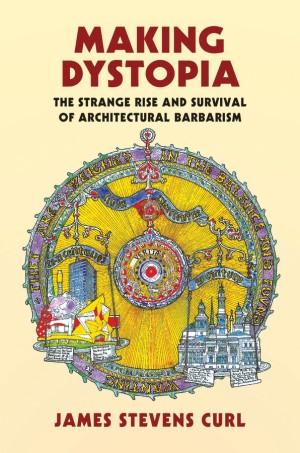In Architect, the Journal of the American Institute of Architects, Witold Rybczynski reviews James Stevens Curl’s Making Dystopia: The Strange Rise and Survival of Architectural Barbarism:
The buildings in my neighborhood, Logan Square in downtown Philadelphia, fall roughly into two categories. There are those that offer visual pleasure, whether they are modest run-of-the-mill brick row houses or the rather grand Board of Education Building, an Art Deco-ish pile topped by busts of Sir Isaac Newton, Ben Franklin, and Alexander Graham Bell. “How nice that someone actually took the trouble,” I think as I walk by. And then there is the second category: utilitarian apartment slabs with unrelieved gridded façades, infill condo housing that looks as if it had been trucked in from the suburbs, a grim precast concrete retirement home that takes up a whole block. “I wish they hadn’t built that,” is my all too common reaction. The Board of Education Building dates from 1932. That’s the approximate cut-off date. Before the 1930s, the buildings are pretty good; after that, not so much. What happened?
The answer to that question is the subject of James Stevens Curl’s controversial new book, Making Dystopia: The Strange Rise and Survival of Architectural Barbarism (Oxford University Press, 2018). Curl is a British architectural historian, professor emeritus at De Montfort University in Leicester, and the author of more than 40 books, including the well-regarded The Victorian Celebration of Death (most recently updated in 2004) and The Oxford Dictionary of Architecture (1999). According to Curl, what happened was “architectural barbarism,” which is how he characterizes modern architecture. He does not mince words. Describing the emergence of the International Style in the 1920s, he writes: “It became apparent that something very strange had occurred: an aberration, something alien to the history of humanity, something destructive aesthetically and spiritually, something ugly and unpleasant, something that was inhumane and abnormal, yet something that was almost universally accepted in architectural circles, like some fundamentalist quasi-religious cult that demanded total allegiance, obedience, and subservience.”[…]
Buildings like PSFS were not the result of the First World War, of course, but it was the war that opened the door to radical change — whether it was political (Nazism), economic (the New Deal), or architectural (Modernism). This, rather than Curl’s theory of a quasi-religious cult, is a more convincing explanation for the “strange rise” of modern architecture. As the title of his book suggests, the author assumes malevolence on the part of Gropius, Le Corbusier, et al., but what if the International Style was instead the result of a sort of postwar architectural PTSD?
[…]
The ultimate failure of modern architecture is not that it was incapable of producing beautiful works of individual art. There have been plenty of those, pace Professor Curl. The real drawback is that while the Modern Movement effectively suppressed an architectural language that had taken hundreds of years to evolve, it proved incapable of developing a successful substitute, the weak-kneed antics of Postmodernism notwithstanding. The strength of pre-modern architecture was that it provided a rich variety of modes of expression. It permitted complicated things to be said in complicated ways, and simpler things in simpler ways, analogous to the spoken language, which can be used to write drama and poetry or instruction booklets.




